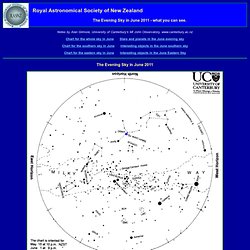

The Southern Evening Sky in August 2011. The Evening Sky in August 2011 - what you can see.

Notes by Alan Gilmore, University of Canterbury's Mt John Observatory, www.canterbury.ac.nz The Evening Sky in August 2011 Chart produced by Guide 8 software; www.projectpluto.com. The Evening Sky in August 2011 - using the chart To use the chart, hold it up to the sky. The Scorpion's tail curls around the zenith. Just north of overhead the orange star Antares marks the heart of the Scorpion. Midway down the southwest sky are 'The Pointers', Beta and Alpha Centauri.
In the western sky are Saturn and Spica making a vertical pair of similar stars, Saturn being the lower of the two. In early August Mercury (not shown) might be seen setting in the western twilight, below and left of Saturn. Saturn is always worth a look in a telescope. Canopus, the second brightest star, is near the south skyline at dusk. The Milky Way is brightest and broadest overhead in Scorpius and Sagittarius. Mars (not shown) rises in the northeast around 5 a.m.
The Southern Evening Sky in June 2011. The Evening Sky in June 2011 - what you can see.

Notes by Alan Gilmore, University of Canterbury's Mt John Observatory, www.canterbury.ac.nz The Evening Sky in June 2011 Chart produced by Guide 8 software; www.projectpluto.com. The Evening Sky in June 2011 - using the chart To use the chart, hold it up to the sky. Sirius twinkles colourfully in the west before setting. Sirius, the brightest star, appears low in the western sky at dusk before setting in the southwest. Midway down the north sky are Saturn and Spica, similar in brightness and colour. Crux, the Southern Cross, is south of the zenith.
Scorpius is midway up the eastern sky, lying on its back. The Milky Way is brightest and broadest in the southeast toward Scorpius and Sagittarius. The Clouds of Magellan, LMC and SMC are in the lower southern sky, easily seen by eye on a dark moonless night. Saturn's rings are "opening" now after being edge-on in recent years. Jupiter (not shown) rises in the east around 4 a.m.
The Southern Evening Sky in July 2011. The Evening Sky in July 2011 - what you can see.

Notes by Alan Gilmore, University of Canterbury's Mt John Observatory, www.canterbury.ac.nz The Evening Sky in July 2011 Chart produced by Guide 8 software; www.projectpluto.com.
Sagittarius. Scutum. Ophiuchus. Serpens. Lyra. Hercules. Cygnus. Aquila.